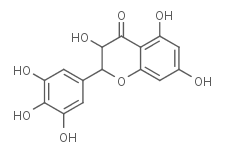
Dihydromyricetin
CAS No. 27200-12-0
Dihydromyricetin( Ampelopsin | Ampeloptin )
Catalog No. M18341 CAS No. 27200-12-0
Dihydromyricetin is a potent inhibitor of dihydropyrimidinase with an IC50 of 48 μM. Dihydromyricetin can activate autophagy by inhibiting mTOR signaling.
Purity : >98% (HPLC)
 COA
COA
 Datasheet
Datasheet
 HNMR
HNMR
 HPLC
HPLC
 MSDS
MSDS
 Handing Instructions
Handing Instructions
| Size | Price / USD | Stock | Quantity |
| 5MG | 35 | Get Quote |


|
| 10MG | 50 | Get Quote |


|
| 50MG | 80 | Get Quote |


|
| 100MG | 125 | Get Quote |


|
| 200MG | Get Quote | Get Quote |


|
| 500MG | Get Quote | Get Quote |


|
| 1G | Get Quote | Get Quote |


|
Biological Information
-
Product NameDihydromyricetin
-
NoteResearch use only, not for human use.
-
Brief DescriptionDihydromyricetin is a potent inhibitor of dihydropyrimidinase with an IC50 of 48 μM. Dihydromyricetin can activate autophagy by inhibiting mTOR signaling.
-
DescriptionAmpelopsin, also known as dihydromyricetin, is a type of flavonoid. It can be found in Cedrus deodara or in the Japanese raisin tree (Hovenia dulcis). It is also found in Erythrophleum africanum. The compound is credited with hepatoprotective effects observed in rodents. Use of Hovenia species in traditional Chinese herbal medicine as a hangover cure has led to research into the potential action of dihydromyricetin in counteracting the effects of alcohol in the brain.
-
In Vitro——
-
In Vivo——
-
SynonymsAmpelopsin | Ampeloptin
-
PathwayOthers
-
TargetOther Targets
-
RecptorGABAR
-
Research AreaCancer
-
Indication——
Chemical Information
-
CAS Number27200-12-0
-
Formula Weight320.25
-
Molecular FormulaC15H12O8
-
Purity>98% (HPLC)
-
SolubilityDMSO : ≥ 100 mg/mL; 312.26 mM
-
SMILESC1=C(C=C(C(=C1O)O)O)[C@@H]2[C@H](C(=O)C3=C(C=C(C=C3O2)O)O)O
-
Chemical Name(2R,3R)-3,5,7-trihydroxy-2-(3,4,5-trihydroxyphenyl)-2,3-dihydrochromen-4-one
Shipping & Storage Information
-
Storage(-20℃)
-
ShippingWith Ice Pack
-
Stability≥ 2 years
Reference
1. Zhang YS, et al. Yao Xue Xue Bao, 2003, 38(4), 241-244.
molnova catalog



related products
-
Enloplatin
Enloplatin is a carboplatin analog that has a partial role in advanced ovarian cancer.
-
DL-5-Hydroxylysine h...
DL-5-Hydroxylysine is a racemic mixture of D- and L- enantiomers of 5-hydroxylysine which may be used as potential target markers for radical-induced protein oxidation.
-
Pegamine
pegamine is a natural product found in Peganum harmala and Peganum nigellastrum, which are novel alkaloids.



 Cart
Cart
 sales@molnova.com
sales@molnova.com


